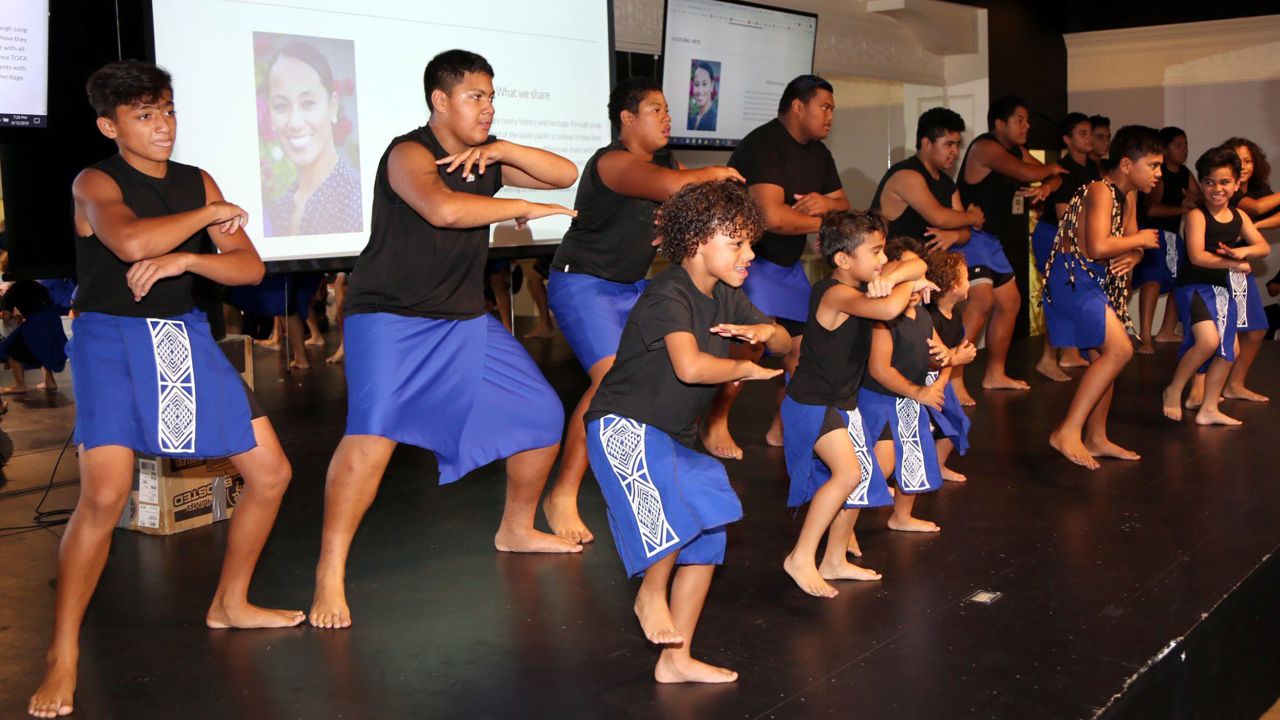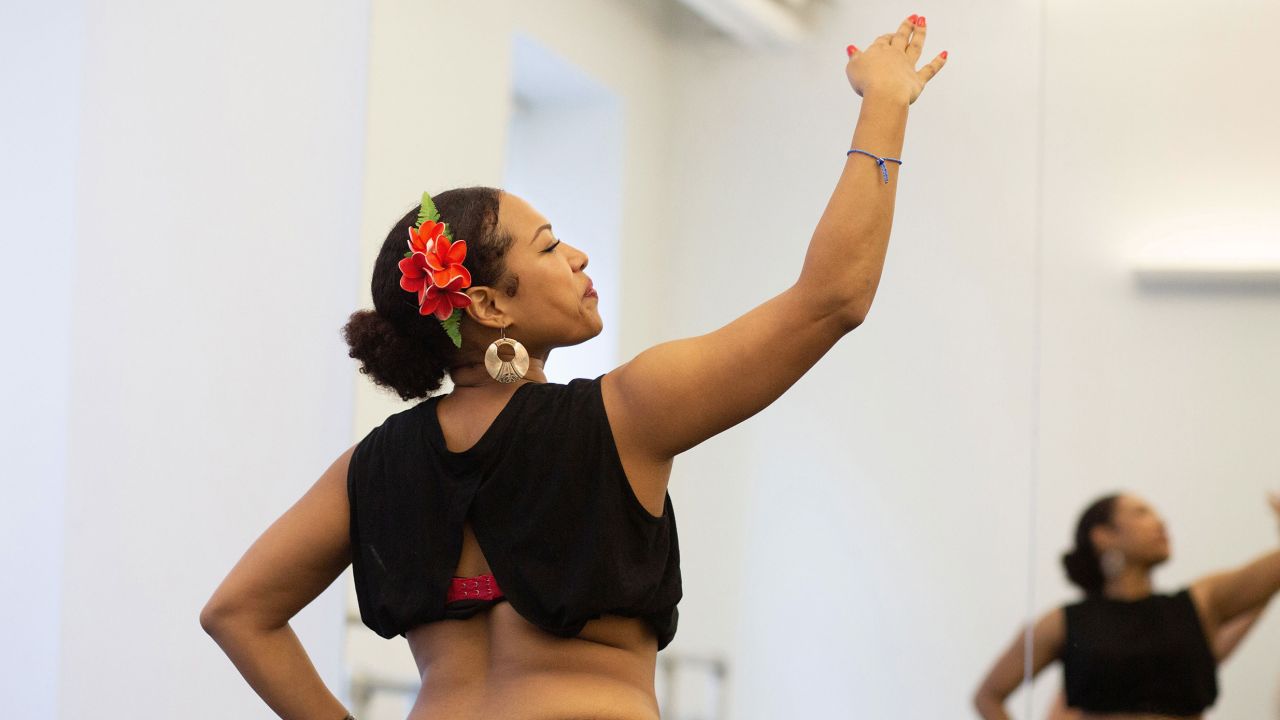In a dance studio nestled inside a building next to New York City Hall, Tamara Bejar Hernandez counts to the beat of a traditional Tahitian dance song as a group of ladies shake their hips from left to right and gracefully glide their hands up in the air and down their arms.
“One, two, three,” Hernandez, founder of the Pacific Islander dance group Lei Pasifika, yells out. “Pretend you’re smelling flowers.”
They are rehearsing choreography for the song “Te Pua No’a No’a,” which tells a story about the flowers spread throughout the island of Tahiti. It’s the same dance I learned a few weeks ago when I decided to join Lei Pasifika’s weekly Tahitian dance classes.
But on this Saturday morning, the ladies are gearing up for Lū’au season, a typically large, vibrant feast featuring live island music and cultural performances from Hawai’i and the greater Polynesia region. Hernandez says the group is booked with performances for the next two months.
“Fa’Arapu,” she calls out over the song chorus, which means to rotate the hips in fast circles.
It’s not the public performances that bring the ladies each week to this humid Manhattan studio. Many tell me it’s their way of staying connected to the Pacific. Some, like me, moved to the city from the Pacific Islands either from the Marshall Islands or Hawaii, while others, like Hernandez, grew up around a fairly large Pacific Islander community elsewhere.
“They come even though they’ve never danced before, but because their parents or family danced before them and they have that connection,” Hernandez tells me. “It makes them less homesick.”
According to the US Census Bureau, Native Hawaiian and Pacific Islanders were the fastest growing ethnic population in the US from 2020 to 2021. The Oceania region — made up of Polynesia, Micronesia, and Melanesia — is home to roughly 10 million people, many of whom have migrated from their home islands to the US mainland due to economic reasons, climate change and better education.
But once in the mainland US, there’s always a sense of yearning for Indigenous culture and traditions. And in big cities with a large Pacific Islander presence, like New York, Portland, Oregon, and San Diego, many US-born Pacific Islanders as well as transplants are keeping their culture alive through dance.
Dancing as a form of storytelling and discipline
“Fix your fingers,” Hernandez tells her dancers, noting that every movement of hands and hips must tell a story.
“‘Aparima,” which means movement of the hand, is a dance style where the hands are the storytellers. When the song they’re rehearsing mentions “’āina” or land, for instance, the dancers elegantly bring their hands up, palms down, to form land in front of them.
Vise Mann, the cultural arts chair for the Sacramento, California-based Pacific Islander group called To’utupu ‘oe ‘Otu Felenite Association (TOFA), or Youth Leaders of the Pacific, says dancing is a form of storytelling. Mann, who is Samoan and born in California, teaches cultural dances for TOFA in the Sacramento region.
It’s a way for Pacific Islanders, especially young people, “to find themselves” and get connected with their ethnic identity and cultures, she notes.
“The dances are an expression of gratitude, of love, of family, the story behind what our ancestors faced and all that they have done to get to where we need,” Mann tells me. “It’s a beautiful thing when you see it being performed.”
In the centuries since the Pacific region was colonized, Pacific Islanders, including the CHamoru, Samoans, Māori, Tongans, Native Hawaiians and more, have lived largely insular lives, separated from the rest of the world by a vast ocean.
This distance taught them to naturally live in harmony with land and sea. Those of us who grew up on the islands always heard stories of their long voyage, during which they danced and sang. They hopped from one island to another by canoe and used only the stars, the currents and the wind to guide them.
Lisa Hafoka, who is Tongan, took over as the president of TOFA in 2022 after the death of her mother, TOFA founder Catherine ‘Ofa Mann. Her family moved to Sacramento from New Zealand in the 1990s and started the organization in 2000 to break down the language and cultural barriers many Pacific Islanders, especially youth, faced in the US at the time.
“When a lot of our Pacific Islander youth were having run-ins with the law, there needed to be a Pacific Islander nonprofit organization that can be like a moderator or go-between for these youth and provide a resource for them to do better in the community,” Hafoka tells CNN.
While TOFA provided resources including counseling and scholarships for young Pacific Islanders, “there’s no Pacific Island organization without a cultural piece, or a dance piece or cultural arts,” Hafoka says.

At the TOFA Scholarships Fundraiser Luau in 2019, the Heartbeats group performs the Māori haka.TOFA Inc.
Now, the group has become a regular presence at the California State Fair in Sacramento, with more than 100 dancers performing traditional dances on stage. Mann says they noticed a growing number of Pacific Islanders, including those who aren’t Native Pacific Islanders but grew up in the islands, wanting to learn more about the culture and participate in dances.
Dancing has become an emotional and cultural outlet for many younger kids, Hafoka says.
“We have found that Pacific Islander children, when they come together, there’s a bond,” she adds. “When they dance together, it’s stronger and they enjoy each other’s company, and they bring in others.”
‘It feels like I’m back home’
Having been born and raised on Saipan in the North Mariana Islands, a US territory just north of Guam, I find myself occasionally feeling homesick after moving to the mainland US.
While I am not Indigenous Pacific Islander, I grew up in a close-knit community of Micronesians on Saipan. I dance their dance, sing their songs, and eat their food, so when I do feel homesick, I turn to dancing, listening to island music, and cooking CHamoru food.
Moving to Portland, Oregon, for college, I was thrilled to find my university had Hawaii and Guam clubs that would put on cultural shows spotlighting traditional dances like the hula and the haka, which I took part in. When I moved even farther away to New York City, where the Pacific Islander population is sparse, it became much more difficult to find community.
Native Hawaiian and Pacific Islanders make only 0.18% of New York City’s total population, according to the US Census Bureau. Washington, California, and Texas are among the top states, besides Hawaii, with the largest NHPI population.
“The Pacific Islander community in New York is not that big, so this feels like a safe space where I can connect with culture and feel like I’m back home,” my friend Liza Atalig, who is CHamoru and also moved from Saipan to New York, tells me.

Linda Peralte practices her hand movement and dance in New York. “Aparima” tends to be slower, focusing on more graceful movements, set to stringed instruments with the dancers’ hands telling a story.Erica Lee/CNN
She was the one who introduced me to Lei Pasifika’s dance classes. And it wasn’t until early this year that I decided I wanted to get back to dancing that I joined and met other dancers who felt the same way.
Kathleen Malpica, 34, another dancer with Lei Pasifika, was born and raised in Hawaii and grew up dancing hula and Tahitian. Like me, she too moved to Oregon before moving to New York City, where she sought after the same community and eventually came across Hernandez and Lei Pasifika.
The best part is “knowing that dance and music and the art of it is so ingrained in the culture and so you’re dancing with a lot of intention and authenticity,” Malpica says. “And the community is why I continue to dance, because the sisterhood of it is really amazing.”
The need for community was the reason Hernandez started the group in the first place. “I started meeting other girls who looked like me,” she tells me.
Moving from Florida, where she grew up in a big Tongan community, to New York, she says, was a big culture shock for her. But one night, at a tiki bar in the city, she met someone from Guam who asked her if she wanted to teach traditional Polynesian dances.
Since 2008, Lei Pasifika has expanded from a small group of girls dancing in New York City parks to a full dance studio, where dancers reserve their spot on a first-come-first-serve basis.
“This becomes your family, it becomes personal, it becomes a part of your every day,” Hernandez says. “Even though I don’t see the girls every day, I think about them every day.”
Source : CNN















